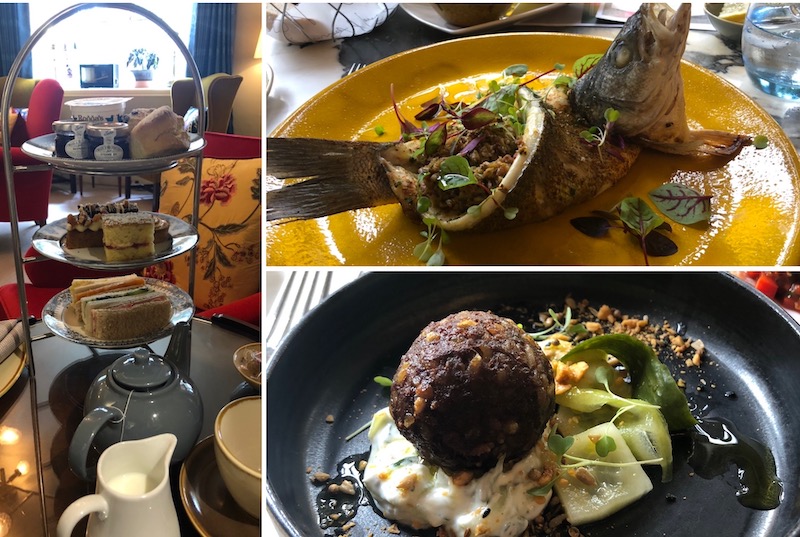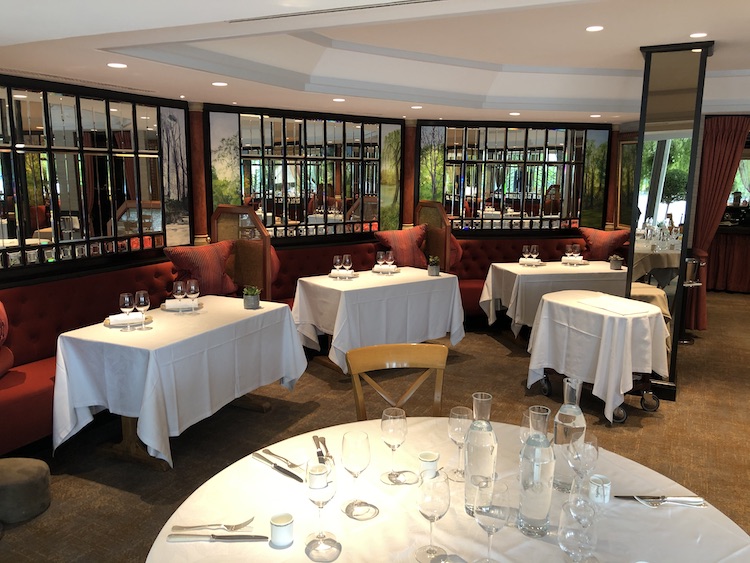Homewood, Freshford. Jamie Forman Exec Chef (August 2020)
Homewood, Freshford. Jamie Forman Exec Chef (August 2020)
The beautiful golden brown and cream stone buildings of Bath, which were constructed using the Jurassic oolitic limestone bricks, provide a feast for the eyes as you drive through and onwards into the countryside. Within ten short minutes you arrive in Freshford, a village which forms part of the bucolic setting of Homewood.

[Homewood, “we are open” in the new normal]
Back in 1998, as Homewood Park, the hotel was awarded a Michelin star and four AA Rosettes under the rising talent of head chef, Gary Jones. Gary had an impressive CV, taking in The Waterside Inn, Le Manoir, Richard Branson’s Necker Island and The Maldives. Post Homewood, Gary went on to achieve greater recognition still at Waldos at Cliveden House and as Head Chef at Le Manoir, where he remains to this day.
In recent years the definition of what luxury means in the context of a country house hotel has somewhat shifted. This is particularly true in the food & beverage department. Once upon a time there was fine napery, smart uniforms and über drilled waiters, as the backdrop to a stiff and rather formal service, which delivered elegant plates of French inspired classical cuisine. Customers were led by the offering and understood that this was what a ‘special treat’ meant.
As part of a separate debate, this fine dining culture may have been derived from how the bourgeoisie behaved in pre-Napoleonic France, where the wealthy had private chefs delivering food in a setting of formal grandeur. The style of food and manner of service became a curiosity to the wider public. In the early 20th century, the newly displaced private chefs, took the opportunity to open the first independent luxury restaurants. In France, at least, ‘fine dining’ became accessible dining by the rationing of money rather than by birth right.
In the UK, hotels like The Savoy or The Ritz were places where you ate if you had a title, indeed as late as the 1960s, you probably needed one to get a table. From 1967, with the Roux brothers giving birth to Le Gavroche, the accessibility of fine dining likewise changed in Britain. The formality and process of what was being offered was unquestionably the experience that was new and exciting. It was what people wanted for their money. Guests would wholeheartedly respect and enjoy being ‘educated.’

[Homewood, The Dining Room]
Perhaps up until a decade or so ago this definition of fine dining in fine places prevailed. Where Michelin were awarding stars would back up this observation. The pace of change has actually been quite fast. Various strands of customer needs have been coming together to change the face of offerings; customers eat out more often and at lower price points, which means that more relaxed dining is preferred; customers have diverse dietary preferences that make fixed repetitive menus difficult and costly to deliver; customers want social meeting places where you happen to have something to eat, with a more relaxed buzz to the atmosphere than the ‘old school’ of hushed reverence in a temple of gastronomy. This dynamic and expanding list of needs is on a path that has shaken luxury hotels, particularly country house hotels, to step up and change to attract the modern monied classes or face closure.

[Homewood: The Front Entrance]
The new Homewood has wholeheartedly embraced all these challenges and turned them into opportunities. Ian and Christa Taylor acquired Homewood in August 2018 and immediately applied their ‘Kaleidoscope’ vision to the property. The words playful and eclectic can be applied throughout Homewood so much so that they appear a deliberate theme – playful topiary figures of animals and a rather surreal yellow submarine, greet you on either side of the driveway. A stone statue of a monkey called Oswald sits at the front door holding a plastic tub of hand sanitiser. Essentially Georgian with some Victorian extensions to the original 13th century frame, eclectic collections (within a grander collection) of paintings, furniture and objects fill the rooms at Homewood; from numerous chandeliers enhancing an already well-lit room; through to a reception boasting a collection of wall mounted clocks. The dining room itself is decorated with a set of almost life size artistic pictures of a youthful looking Peter Gabriel, whose residential studios to this day are based in Box, near Bath.

[Executive Chef: Jamie Forman]
Executive chef Jamie Forman has developed an impressive CV. In the early 1990s, Jamie invested three years training at Stratford College before making an initial foray into professional kitchens under Clive Fretwell at Le Manoir. The next step was four years at Lower Slaughter Manor, which had two Egon Ronay stars and one Michelin star under Head Chef Alan Dann.
From 2001, Jamie started his association with Ian & Christa Taylor, spending eight years in total at Cotswold House Hotel in Chipping Campden, where he worked as sous chef for four of the eight years under the Roux Scholar Simon Hulstone. When Simon moved on to set up The Elephant in Torquay (where he quickly gained a Michelin star), Jamie took over as head chef at Cotswold House and was awarded an Espoirs or Michelin Rising Star. His next adventure was the Dialhouse Hotel at Bourton on the Water before moving on to Holbrook House in Somerset. Most recently prior to Homewood, Jamie was headhunted as Group Executive Chef for six hotels. The first eighteen months of which saw him opening the £1.8m refurbished flagship, Burley Manor in the New Forest, where he directed the menu concept and recruitment of key staff. In February 2019, Jamie was reacquainted with Ian & Christa Taylor for the project at Homewood.

[Homewood: The new outdoor dining terrace that inspired the Olio Menu]
Jamie’s dining concept and menu at Homewood is in keeping with the playful and eclectic themes of the owners’ vision for the property. The menu is referred to as Olio, which when enquiring as to the meaning, was described as something having a Mediterranean feel. This idea is perhaps in keeping with the new outdoor terrace and kitchen. A look in the dictionary and Olio literally means either a highly spiced stew of various meats and vegetables from Spain or Portugal or more simply ‘a miscellaneous collection of things.’ The latter makes total sense as the menu encapsulates Somerset bites, small plates and sharing plates; a section covering Robata, Plancha or Skillet cooking apparatus for the larger, more traditional main courses; a section of woodfired flatbreads; further sections cover hearty salads, sides and desserts.
The one menu for all occasions is actually a biproduct of the Covid-19 lockdown. “We were toying with the idea of one menu for fine dining inside and the Olio menu for the terrace outside,” says Jamie. However, they noticed that post lockdown people were checking in at a wider variety of timings, and that these guests might like a small plate or something to share upon arrival before getting changed for dinner. In fact, “having just the one broad menu has worked very well, not only with these guest patterns but generally striking a chord with what people want,” adds General Manager Ed Fitzpatrick. Jamie’s philosophy is to acquire the best possible produce and prepare it simply, allowing the natural flavours to speak for themselves. They will source scallops from the Isle of Skye with an eye on sustainability as well as quality, or source Bass from the likes of the well-respected Flying Fish company.

All tastes, appetites and age groups are catered for as witnessed by several multi-generational family gatherings at tables eating together, enjoying a relaxed meal over an extended Sunday lunch. The menu and indeed the variety of settings offered – outdoor terrace, indoor dining room or lounges – hits all the right notes in the modern era. Traditional battered haddock, ‘seaweed’ chips and crushed minted peas, or the option of a steak burger mean the menu could be part of a smart pub. These are, however, complemented by the more ambitious dishes such as Seasbass “branzino” (an Italian or European Bass) which comes with the head and the tail, chermoula and lemon. The salads, flatbreads and sharing plates mean there’s something for all appetites, eating preferences (whole dish or share) and occasions (relaxed or more formal).

The Homewood kitchen was well employed during lockdown, with the provision of charity meals. These were launched on social media with an offering of £8 for fish and chips takeaway. An impressive 180 customers ordered on Saturday nights, with proceeds going to Royal United Hospitals Bath. A Thursday take away comprising a burger night followed, with those proceeds going to the Holburne Museum and Bath festivals. “We underestimated the power of the targeted Facebook campaign we did to launch these offerings and the high knock on level of business we’ve experienced post reopening,” says Jamie. Homewood also enrolled in the government backed, Eat Out to Help Out scheme offering up to £10 discount per person (based on 50% of food and soft drink orders), to boost weekday trade post opening and throughout August.
The service is excellent throughout the hotel, no more evident than in the dining room, where key staff are relaxed, friendly, informative, engaging and professional. An overriding sense of happy energy pervades, which enhances the attractiveness of the soul of the building.
Overall, Homewood represents an exciting project, not just for Ian & Christa Taylor but for General Manager Ed Fitzpatrick and Head Chef Jamie Forman. With dynamic and fluid developments ahead, they seek to deliver a completely satisfying experience to guests in the modern era of country house hotel luxury. Fine dining guide looks forward to following their undoubted successes with interest.
from Fine Dining Guide






























Recent Comments